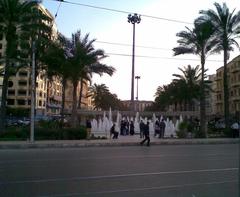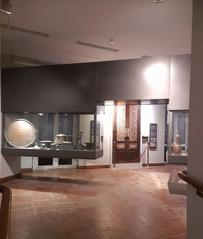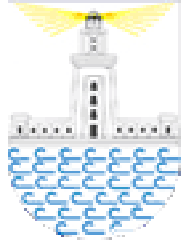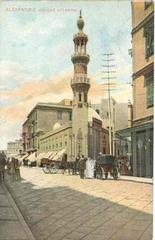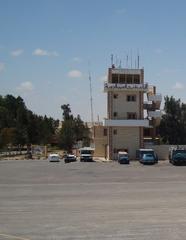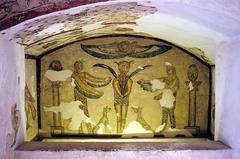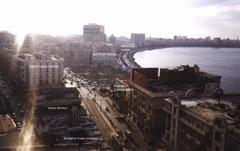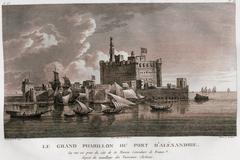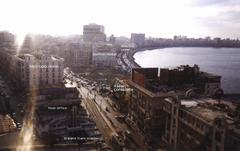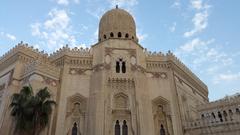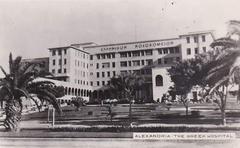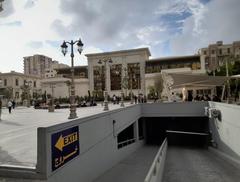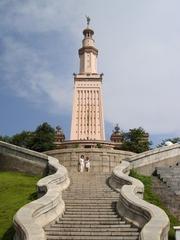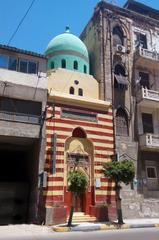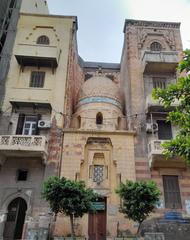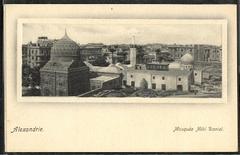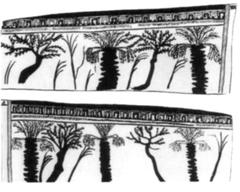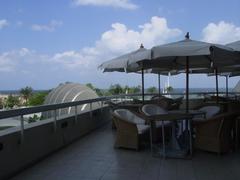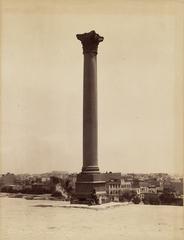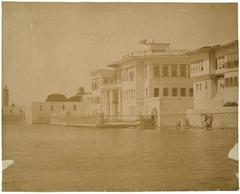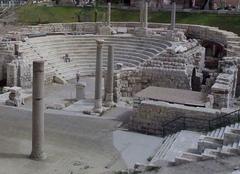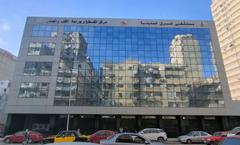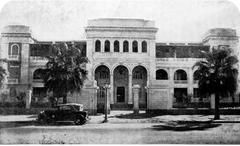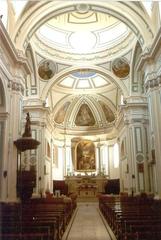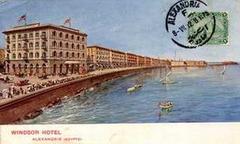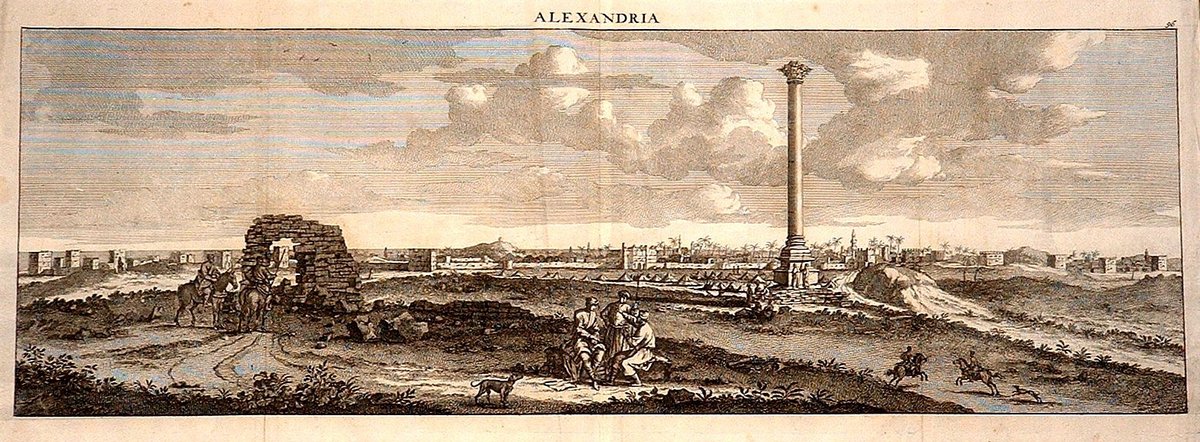
Pompey’s Pillar and the Archaeological Park in Alexandria Visitor Guide
Date: 18/07/2024
Introduction to Pompey’s Pillar
Nestled in the historic city of Alexandria, Egypt, Pompey’s Pillar and the Archaeological Park represent a remarkable blend of Greco-Roman and Egyptian heritage. This towering monument, despite its misleading name, was not erected in honor of the Roman general Pompey but was commissioned by Emperor Diocletian in 297 AD to commemorate his victory in a local uprising (source). Standing at a height of 26.85 meters and weighing an estimated 285 tons, Pompey’s Pillar is a testament to the architectural prowess of ancient civilizations (source). Surrounding this monumental column is the Archaeological Park, once home to the grand Temple of Serapis, known as the Serapeum, which symbolized the cultural fusion of Greek and Egyptian traditions during the Roman era (source). As one of Alexandria’s most iconic sites, Pompey’s Pillar and the Archaeological Park offer visitors a glimpse into the city’s illustrious past and the complex interplay of cultures that defined it.
Table of Contents
- Introduction
- Historical Background and Significance
- Key Attractions and Features
- Visitor Information
- Travel Tips
- Nearby Attractions
- Special Events and Guided Tours
- Photographic Spots
- FAQ
- Conclusion
Historical Background and Significance
The Enigma of Pompey’s Pillar
Erected in 297 AD, the pillar predates Pompey’s presence in Egypt by centuries. It was actually commissioned during the reign of Emperor Diocletian, a powerful Roman ruler, to commemorate his victory in a local uprising. The pillar’s original purpose was to serve as a monumental column within the Temple of Serapis, a grand complex dedicated to the Greco-Egyptian god Serapis.
The Temple of Serapis - A Fusion of Cultures
The Temple of Serapis, also known as the Serapeum, was once a magnificent testament to the cultural fusion that characterized Roman Egypt. This vast sanctuary housed a library, lecture halls, and religious structures, rivaling the famed Library of Alexandria in its grandeur. The temple’s namesake, Serapis, embodied this cultural blend by combining elements of Greek and Egyptian gods, including Zeus, Osiris, and Apis.
A Glimpse into Alexandria’s Past
Pompey’s Pillar and the surrounding archaeological site offer a tangible link to Alexandria’s illustrious past. The pillar’s imposing scale and intricate carvings, though weathered by time, hint at the city’s former glory as a center of learning, commerce, and cultural exchange. The Serapeum, once a vibrant hub of religious and intellectual life, met its demise in 391 AD when it was destroyed by a Christian mob during a period of religious strife, marking a turning point in Alexandria’s history.
Unraveling the Mysteries
Despite its historical significance, Pompey’s Pillar and the Serapeum remain shrouded in mystery. The exact layout and function of many structures within the temple complex are still debated by archaeologists. Excavations continue to unearth new artifacts and insights, gradually piecing together the puzzle of this ancient site.
Key Attractions and Features
Pompey’s Pillar
Towering over the ancient city, Pompey’s Pillar is the most prominent feature of the Archaeological Park. This impressive structure, standing at approximately 26.85 meters (88 feet) tall, is a testament to Alexandria’s rich past. Carved from a single granite shaft, the pillar is estimated to weigh a staggering 285 tons. Despite its name, the pillar has no historical connection to the Roman general Pompey. It was actually erected in 297 AD in honor of Emperor Diocletian, commemorating his victory in a rebellion in Alexandria.
The Two Sphinx Statues
Guarding the base of Pompey’s Pillar are two sphinx statues, adding to the site’s mystique. These granite guardians, while smaller than the famed Sphinx of Giza, offer a glimpse into the Egyptian tradition of incorporating these mythical creatures into their monumental architecture.
The Serapeum
While only ruins remain, the Serapeum was once a grand temple dedicated to the Greco-Egyptian god Serapis. This temple, dating back to the Ptolemaic dynasty, was a center of religious syncretism, blending Greek and Egyptian beliefs. The Serapeum was a renowned center of learning, housing a vast library that rivaled the famous Library of Alexandria. Its destruction in 391 AD by a Christian mob marked a significant turning point in the decline of classical knowledge. Today, visitors can explore the remnants of the Serapeum, including underground chambers and passages that once housed the temple’s treasures.
The Apis Bulls
Within the Archaeological Park, you’ll find evidence of the veneration of Apis Bulls, sacred animals in ancient Egyptian religion. These bulls, believed to be the living embodiment of the god Ptah, were mummified and interred with great ceremony. The nearby Catacombs of Kom El Shoqafa served as a burial ground for both humans and Apis Bulls, showcasing a fascinating blend of Egyptian, Greek, and Roman artistic styles.
The Roman Amphitheater
A testament to Alexandria’s Roman past, the ruins of a Roman amphitheater lie within the Archaeological Park. This well-preserved amphitheater, dating back to the 2nd century AD, offers a glimpse into the entertainment and social life of Roman Alexandria. The amphitheater features a semi-circular seating arrangement, orchestra pit, and stage area.
The Cisterns
Beneath the surface of the Archaeological Park lies a network of ancient cisterns, a testament to the city’s sophisticated water management system. These underground chambers, built by the Romans, collected and stored rainwater, ensuring a constant supply for the city’s inhabitants. The cisterns are an impressive feat of Roman engineering, showcasing their advanced understanding of hydraulics and construction techniques. Some of these cisterns are accessible to the public, offering a unique perspective on the city’s infrastructure.
The Gardens
Surrounding the historical monuments, the Archaeological Park features beautifully landscaped gardens. These green spaces provide a tranquil respite from the bustling city, offering a serene setting to appreciate the historical significance of the site. The gardens offer panoramic views of the surrounding area, including glimpses of the Mediterranean Sea.
Visitor Information
Visiting Hours
Pompey’s Pillar and the Archaeological Park are open daily from 9:00 AM to 5:00 PM. It is recommended to check for any changes in the schedule or special closures before planning your visit.
Ticket Prices
The entrance fee for Pompey’s Pillar is 80 EGP for adults and 40 EGP for students. Discounts may be available for group bookings and Egyptian nationals.
Accessibility
The site is partially accessible to visitors with disabilities. However, due to the ancient nature of the ruins, some areas may be challenging to navigate.
Travel Tips
- Wear comfortable shoes as there is a lot of walking on uneven terrain.
- Bring water and sun protection, especially during the summer months.
- Consider hiring a local guide to enrich your experience with historical anecdotes and detailed explanations.
Nearby Attractions
- Bibliotheca Alexandrina - A modern library and cultural center built near the site of the ancient Library of Alexandria.
- Qaitbay Citadel - A stunning fortress offering panoramic views of the Mediterranean Sea.
- Kom El Shoqafa Catacombs - A historical archaeological site known for its unique blend of Pharaonic and Greco-Roman art.
Special Events and Guided Tours
Special events and guided tours are often organized at Pompey’s Pillar. Check the official website or local tourism offices for the latest information on available tours and upcoming events.
Photographic Spots
- The base of the pillar for capturing its grandeur and scale.
- The surrounding ruins of the Serapeum, especially during sunset for dramatic lighting.
- Views from the nearby hill, offering a panoramic perspective of the site and Alexandria.
FAQ
Q: What is the best time to visit Pompey’s Pillar?
A: The best time to visit is during the cooler months, from October to April, to avoid the intense summer heat.
Q: Are there any guided tours available?
A: Yes, guided tours are available and highly recommended for a deeper understanding of the site’s history.
Q: Can I buy tickets online?
A: Currently, tickets are only available at the entrance. However, it is advisable to check the official website for any updates.
Conclusion
Visiting Pompey’s Pillar and the Serapeum is akin to stepping back in time. It’s an opportunity to marvel at the architectural prowess of a bygone era, contemplate the cultural forces that shaped Alexandria, and ponder the mysteries that still lie buried beneath the sands of time.
Call to Action
If you found this article helpful, follow us on social media for more updates on historical sites and travel tips. Don’t forget to download our mobile app Audiala for a comprehensive guide to Alexandria and other fascinating destinations.
Summary of Key Points About Pompey’s Pillar
Visiting Pompey’s Pillar and the Archaeological Park is more than just a historical excursion; it’s a journey through time, offering a unique perspective on the rich cultural tapestry of Alexandria. From the imposing red granite column to the ruins of the Serapeum, each element of the site tells a story of ancient grandeur, religious syncretism, and the rise and fall of empires (source). The site’s historical significance, combined with its architectural marvels and serene gardens, makes it a must-visit for history enthusiasts and casual travelers alike. By exploring Pompey’s Pillar, visitors can appreciate the intricate carvings, the symbolic sphinxes, and the remnants of Alexandria’s vibrant past, all while contemplating the mysteries that still lie buried beneath the sands of time (source). Whether you’re drawn by the allure of ancient monuments or the desire to understand the cultural forces that shaped one of the world’s greatest cities, Pompey’s Pillar and the Archaeological Park promise an enriching and unforgettable experience.
Sources and Further Reading
- Visiting Pompey’s Pillar and the Serapeum - History, Tickets, and Travel Tips, 2024, Author source
- Visiting Pompey’s Pillar - Hours, Tickets, and Historical Insights in Alexandria, 2024, Author source
- Ultimate Guide to Visiting Pompey’s Pillar and the Serapeum - Tips, Tickets, and Travel Information, 2024, Author source


